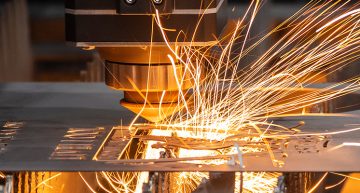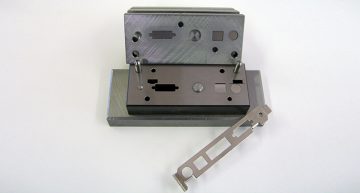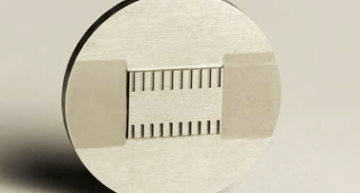In metal processing, many different products are created every day. To give them the desired shape, it is often necessary to bend metal accordingly.
Very often, sheet metal must be formed for this purpose – these are pieces of metal that are a few millimeters thick. Bending metal can also be called folding. It is possible to bend a sheet up to an angle of 180 degrees. Larger angles are also possible, but then the process is called something else (folding).
Why do you need a bending machine?
Biegen oder Abkanten per Hand ist sehr mühsam. Deshalb werden immer mehr Maschinen eingesetzt. Die Vorteile: Sie arbeiten schnell und hochpräzise. Zudem sind sie in der Lage, selbst unhandliche und schwere Blechplatinen verarbeiten zu können. Der Biegevorgang wird automatisch ausgeführt. Diese Maschinen können sehr schnell umgerüstet und somit umgehend an Kundenwünsche angepasst werden – ein grosser Pluspunkt.
What is a bending machine?
A bending machine produces bends on a workpiece by means of a straight-line or rotating movement. Here, modern, computer-controlled CNC bending machines are characterized by particularly short setup times and a high degree of flexibility. With these high-performance bending machines, individual parts can be bent just as economically as series parts. A bending machine consists of a basic machine that can be set up with little effort and used for a wide variety of bends – a simple plug-in system makes it possible to change tools in just a few seconds.
Types of bending
Bending tools are differentiated according to the type of bend generated. Either the bending angle is set with the help of a reference bend and the machine converts the bending angle – as is the case with CNC machines – into a stroke distance, or the bending tool itself has an angle sensor.
Standard bends are all bends that do not have an unusual geometry. Here, the bend is relatively far away from the material ends, there is therefore sufficient contact surface on the tool and the distance to a second bend is large. The tool used here is a bending die with an electronic bending tool or a mechanical bending prism. In U-bending, several bends are made very close to each other and finally result in the finished shape. Instead of a bending punch, a bending mandrel is used here; it is much narrower. A stack bending tool is used when two bends are to be produced at the same time with a small distance between them.
If the bending axis is parallel to the narrow side of a workpiece, an upright bending tool is used. A torsion bending tool is used to twist the workpiece along the longitudinal axis.
How a bending machine works
Sheet metal can be professionally bent by bending or folding. For this purpose, the metalworking industry uses modern bending machines. There are different methods how sheet metal can be bent: Die bending, swing bending, roll bending and hot bending. Die bending is widely used in industrial sheet metal processing. A so-called press brake, bending press or press brake is used for this purpose. Here’s how it works: press brakes have a hydraulically or electrically operated press beam that is lowered from above. A suitable punch, which has been selected in advance, sits on the head of the press beam. Now the press beam cants the sheet: The punch presses from above into the die until the desired bending angle is reached. Depending on how far the press beam is lowered, smaller or larger bending angles are produced.
In swivel bending, the sheet is pressed against the lower beam by an upper beam. A third beam, the bending beam, ensures the angle in the sheet. Roll bending – also called “roller bending” – is a special form of swing bending. Here, the bending beam moves away from the sheet in a controlled manner during the swiveling movement. The sheet metal lies firmly on the machine. Advantage: There is no friction that could damage or soil the material. Roll bending is used for rounding sheet metal, e.g. tubes or profiles for railings. Some metals cannot be processed directly, but must first be heated. Only then is processing possible. In this case, hot bending is used. These processes are very laborious and almost impossible to perform by hand.
Specialist for prototype construction and small series production of bending tools
RETERO GmbH is able to produce prototypes or small series of 5,000 to 10,000 bent parts at short notice and at low cost. In a first phase, a pilot series is manufactured using auxiliary bending tools. After the parts have been inspected and accepted by the customer, the definitive bending tools can be designed and manufactured for a corresponding series production. This avoids high initial or modification costs for expensive tools that have already been manufactured. Depending on the customer’s requirements, stamping and bending tools are manufactured which can then be integrated into production lines or processes
Retero AG
Stadtweg 24
8245 Feuerthalen



